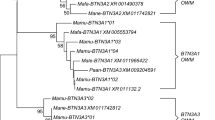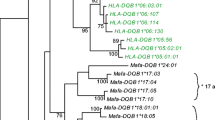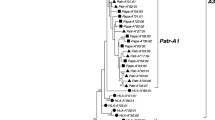Abstract
The defective major histocompatibility complex (MHC) DRB6 gene is transcribed into mRNA in human [peripheral blood lymphocytes, transfected and Epstein-Barr virus (EBV)] and chimpanzee EBV cell lines. MHC-DRB6 presents several anomalies, which include stop codons in exon 2, lack of the usual polyadenilation signal of other MHC-DRB genes, and a promoter region and exon 1 taken from a locally inserted retrovirus. The complete cDNA sequences from human DRB6*0201 and three common chimpanzee alleles (Patr-DRB6*0108, Patr-DRB6*0109, Patr-DRB6*0111) have been obtained; two exon 1-exon 2 cDNA sequences from bonobos (Papa-DRB6*0101 and Papa-DRB6*0102) are also shown. In contrast to chimpanzee DRB6 transcripts, the human ones: (1) present an exon 1-exon 2 splicing site that includes the transcription of the first 141 nucleotides of intron 1, rendering a longer exon 1, and (2) show a duplication of exon 6, which would render a longer cytoplasmic tail in a putative DRB6 protein. These two characteristics are found in all the human sequences obtained, regardless of the cellular type tested, and they are not present in any of the chimpanzee alleles reported; consequently, they are human-specific. All the alleles reported here bear stop codons in the three possible reading frames; however, a certain level of expression of DRB6 has been observed by cytofluorometry. This could be due to the presence of a selenocysteine insertion sequence (SECIS) stem-loop structure located at the 3 untranslated region of the DRB6 mRNA, which directs selenocysteine incorporation at UGA codons. DRB6 transcription and translation would be the first gene model of a readingthrough stop codon mechanism in primate MHC. It is also feasible that the DRB6 gene might generate a population of short polypeptides, bound to plasmatic membranes, having non-antigen-presenting functions or which are presented by other MHC molecules as HLA-E presents HLA-G and -B leader sequence-derived peptides.
Similar content being viewed by others
Author information
Authors and Affiliations
Additional information
Received: 2 February 1999 / Revised: 15 April 1999
Rights and permissions
About this article
Cite this article
Moreno-Pelayo, M., Fernández-Soria, V., Paz-Artal, E. et al. Complete cDNA sequences of the DRB6 gene from humans and chimpanzees: a possible model of a stop codon readingthrough mechanism in primates. Immunogenetics 49, 843–850 (1999). https://doi.org/10.1007/s002510050563
Issue Date:
DOI: https://doi.org/10.1007/s002510050563




